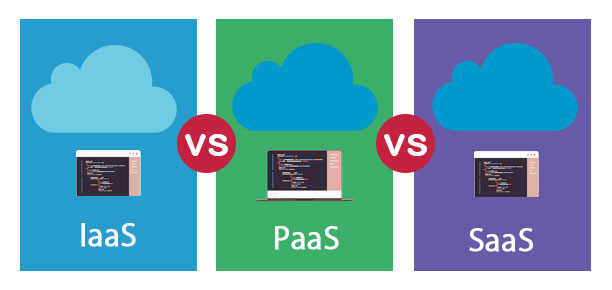In today’s digital landscape, cloud computing has become the cornerstone of technological advancements, offering businesses and individuals scalable and flexible solutions. However, navigating the cloud isn’t a one-size-fits-all journey. Delving into the intricacies of cloud computing involves unraveling the cloud layers, with a keen focus on understanding the SaaS, PaaS, and IaaS differences, as each of these services plays a distinct role in shaping the landscape of modern technology infrastructure.Understanding the distinctions between Software as a Service (SaaS), Platform as a Service (PaaS), and Infrastructure as a Service (IaaS) is paramount. Let’s unravel these cloud layers to demystify their roles and applications.
1. Software as a Service (SaaS): A User-Friendly Horizon
SaaS is the most user-centric layer of cloud computing. It delivers software applications over the internet, eliminating the need for users to install, maintain, or update them locally. Examples of SaaS include Google Workspace, Microsoft 365, and Salesforce.
Why SaaS?
SaaS simplifies accessibility, making software available on various devices. It’s like renting a fully furnished apartment—move-in ready without the hassle of furniture shopping or maintenance.
Advantages of SaaS:
-
Accessibility from any device.
-
Automatic updates for the latest features.
-
Cost-effective with no hardware or maintenance requirements.
Potential Drawbacks:
-
Limited customization compared to on-premise solutions.
-
Dependency on the internet for functionality.
2. Platform as a Service (PaaS): The Middle Ground for Developers
PaaS sits between SaaS and IaaS, providing a platform that allows developers to build, deploy, and manage applications without worrying about the underlying infrastructure. It’s like a pre-built kitchen in a house—developers focus on cooking (code) rather than constructing cabinets (infrastructure).
Why PaaS?
PaaS accelerates application development and deployment, fostering innovation without the burden of infrastructure management. It’s an ideal playground for developers.
Advantages of PaaS:
-
Streamlined development process.
-
Centralized infrastructure management.
-
Scalability without the hassle of hardware concerns.
Potential Drawbacks:
-
Limited control over underlying infrastructure.
-
Platform-specific constraints can affect certain development choices.
3. Infrastructure as a Service (IaaS): Building Blocks for Tech Architects
IaaS provides virtualized computing resources over the internet, giving users control over the fundamental building blocks of computing infrastructure. It’s like purchasing land to construct a building—total control from foundation to roof, but without the hassle of land ownership.
Why IaaS?
IaaS is for businesses and individuals needing full control over their computing environment without the overhead of physical hardware management.
Advantages of IaaS:
-
Full control over virtualized infrastructure.
-
Scalability based on demand.
-
Flexibility to install and configure software.
Potential Drawbacks:
-
Responsibility for security and maintenance.
-
Requires technical expertise for optimal utilization.
4. Navigating the Cloud: Making Informed Choices
Choosing the Right Model:
Consider Your Needs:
-
Evaluate your requirements—whether it’s software accessibility, development flexibility, or infrastructure control.
Scalability Matters:
-
If scalability is a priority, SaaS and IaaS may be suitable, depending on the level of control you desire.
Development Focus:
-
If you’re a developer, PaaS might be the sweet spot, allowing you to concentrate on coding without infrastructure distractions.
Integration Challenges:
Interoperability Concerns:
-
Ensure compatibility between different cloud models when integrating multiple services.
Data Portability:
-
Assess how easily you can move data between different cloud services in case of changing needs or providers.
Cost Considerations:
-
Understand the cost structures of each model, factoring in potential scaling needs and data usage.
Real-world Applications:
SaaS in Action:
-
Imagine a small business leveraging SaaS for customer relationship management (CRM)—accessing data from anywhere without the need for an on-premise server.
PaaS Empowering Developers:
-
Consider a software development team using PaaS to streamline collaboration and deployment, focusing solely on code innovation.
IaaS for Enterprise Control:
-
Picture an enterprise utilizing IaaS to build a customized infrastructure tailored to their specific security and compliance needs.
5. Challenges and Future Trends: Navigating the Cloud’s Evolution
Common Challenges:
Security Concerns:
-
Security remains a paramount concern across all cloud models, emphasizing the need for robust encryption and access controls.
Data Privacy:
-
Compliance with data protection regulations poses challenges, requiring cloud providers to adopt stringent privacy measures.
Emerging Trends:
Serverless Computing:
-
The rise of serverless computing abstracts infrastructure management, allowing developers to focus solely on code.
Multi-Cloud Strategies:
-
Businesses increasingly adopt multi-cloud approaches, distributing workloads across various cloud providers for redundancy and flexibility.
Edge Computing Integration:
-
Edge computing, bringing processing closer to the data source, gains prominence for faster response times in IoT applications.
Conclusion: Navigating the Cloud’s Vast Expanse
In conclusion, understanding the nuances of SaaS, PaaS, and IaaS is crucial for making informed decisions in the digital era. Whether you’re a small business seeking streamlined solutions, a developer aiming for coding agility, or an enterprise craving infrastructure control, the cloud offers tailored options. As cloud technology evolves, staying abreast of emerging trends and addressing common challenges ensures a seamless journey through the layers of SaaS, PaaS, and IaaS. So, embrace the cloud wisely, unlocking its full potential for innovation and efficiency.


